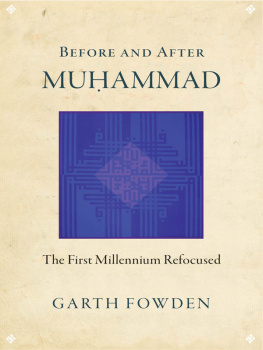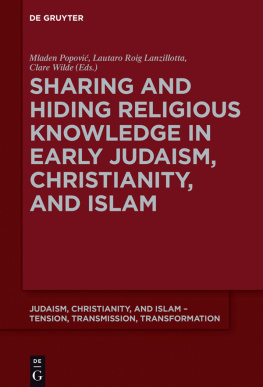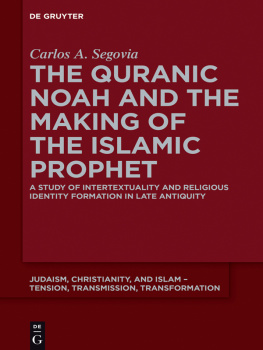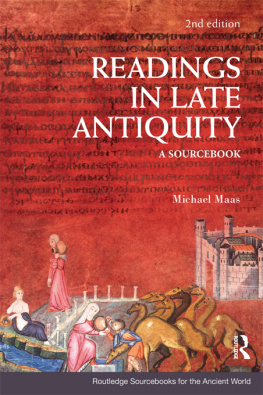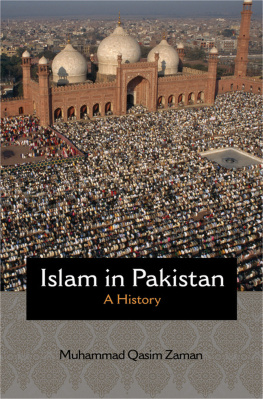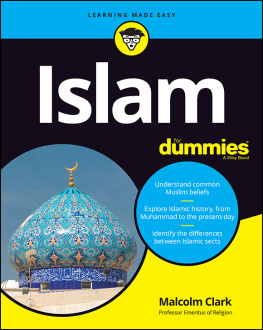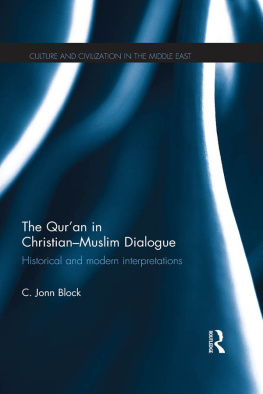
BEFORE AND AFTER MU H AMMAD
BEFORE AND AFTER MU H AMMAD
THE FIRST MILLENNIUM REFOCUSED
Garth Fowden
PRINCETON UNIVERSITY PRESS
PRINCETON AND OXFORD
Copyright 2014 by Princeton University Press
Published by Princeton University Press, 41 William Street, Princeton, New Jersey 08540
In the United Kingdom: Princeton University Press, 6 Oxford Street, Woodstock, Oxfordshire OX20 1TW
press.princeton.edu
All Rights Reserved
ISBN 978-0-691-15853-2
Library of Congress Control Number 2013942727
British Library Cataloging-in-Publication Data is available
This book has been composed in Garamond Premier Pro
Printed on acid-free paper.
Printed in the United States of America
1 3 5 7 9 10 8 6 4 2
aug. mmix
Prefatory Note and Acknowledgments
Before and after Mu h ammad develops my attempt in Empire to commonwealth (1993) to view Arsacid and Sasanid Iran, Rome, and the Caliphate within a single frame. Since then I have approached the early Caliphate by way of its material culture in Qu s ayrAmra (2004), and through philosophy (especially the Arabic Plotinus) in an uncompleted book titled Rational Islam and the reinvention of Aristotle. Except in its definition of the geographical framework, Before and after Mu h ammad barely overlaps with Empire to commonwealth; but it has been much fertilized by Rational Islam. It lays out, and in its last two chapters somewhat schematically exemplifies, a new historical periodization, whose practical demonstration will be provided, in due course, by a large-scale narrative to be titled The First Millennium: From Augustus to Avicenna.
Unless specified otherwise, all dates are CE, and translations listed in the notes are into English. There is no bibliography. All references are given in full at their first occurrence and in abbreviated form thereafter, with their first occurrence indicated in square brackets by chapter and footnote number separated by a colon (e.g., [2:32]). The first epigraph excerpt is from Sebastian Brocks article From antagonism to assimilation: Syriac attitudes to Greek learning, 1982, Dumbarton Oaks Research Library and Collection, Trustees for Harvard University. Originally published in East of Byzantium: Syria and Armenia in the formative period, edited by Nina G. Garsoan, Thomas F. Mathews, and Robert W. Thomson.
I would like to thank Johann Arnason for his early interest in and encouragement of my First Millennium project, and Glenn Most for inviting me to give three lectures, titled Beyond late Antiquity, at the Scuola Normale Superiore, Pisa, in April 2009. Rob Tempio, of Princeton University Press, suggested I turn these into a short book. I wrote a first draft during three intense weeks of August 2009 at Katounia, Limni, in the pine woods by the Euboean Gulf, where forty years earlier Dimitri Obolensky composed The Byzantine Commonwealth (1971), and Philip Sherrard worked until his untimely death in 1995. I am grateful to Denise Sherrard for her ever-generous hospitality.
Otherwise, Before and after Mu h ammad was conceived and written in the uniquely favorable environment provided by the Department of Greek and Roman Antiquity at the Institute of Historical Research, National Research Foundation, Athens, and in particular by Anna Mihailidou (Acting Director) and Harikleia Papageorgiadou (Head of Department), who sacrificed time and energy to protecting their colleagues from the worst effects of the Greek economic collapse. The book was completed in the winter of 201213, when I was fortunate to be a fellow of the Wissenschaftskolleg zu Berlin, and finally caught up with many publications not available in Greece.
Among those who have read part or all of this book, or otherwise assisted at its birth, the following deserve special thanks: Nadia Ali, Aziz al-Azmeh, Kamal Boullata, Hariclia Brecoulaki, Peter Brown, Elizabeth Key Fowden, Luca Giuliani, Anthony Kaldellis, Myrto Malouta, and Walter Pohl. I also thank all those who organized (Johann Arnason, Bo Strth) and took part in the meeting on The European foundation myth: A critical assessment and a relativisation of the European origo, which was convened at the University of Helsinki in May 2011 in order to discuss the Before and After Mu h am-mad/First Millennium project.
Finally, I thank Elizabeth and Gabriel for the good humor and solidarity that have kept us going through the last three and a half difficult years of crisis in Greece and temporary departure.
Wissenschaftskolleg zu Berlin
30th January 2013
Abbreviations
ASAP | Arabic sciences and philosophy (Cambridge) |
CAH | The Cambridge ancient history vol. 122, ed. A. K. Bowman and others (Cambridge 2005); vol. 14, ed. Av. Cameron and others (Cambridge 2000) |
DPA | R. Goulet (ed.), Dictionnaire des philosophes antiques (Paris 1989) |
EIr | E. Yarshater (ed.), Encyclopaedia Iranica (London; Costa Mesa, Calif.; New York 1985); and www.iranicaonline.org, including supplements to printed volumes and content for forthcoming volumes |
EIs2 | H. A. R. Gibb, J. H. Kramers, E. Lvi-Provenal, and J. Schacht (eds.), The encyclopaedia of Islam (Leiden 196020092) |
EIs3 | M. Gaborieau and others (eds.), The encyclopaedia of Islam three (Leiden 2007) |
EQ | J. D. McAuliffe (ed.), Encyclopaedia of the Qurn (Leiden 20016) |
Gibbon | E. Gibbon (ed. D. Womersley), The history of the decline and fall of the Roman Empire (London 1994); citations consist of the chapter number followed by the volume and page in Womersleys edition (e.g., 7: 1.195, 15: 1.480 n. 96, 40: 2.565 n. 24) |
IBALA | J. Lssl and J. W. Watt (eds.), Interpreting the Bible and Aristotle in late Antiquity: The Alexandrian commentary tradition between Rome and Baghdad (Farnham 2011) |
JLA | Journal of late Antiquity (Baltimore) |
PIW | U. Rudolph (ed.), Philosophie in der islamischen Welt 1: 8.-10.Jahrhundert (Basel 2012) |
Pocock | J. G. A. Pocock, Barbarism and religion (Cambridge 1999) |
SEP | E. N. Zalta (ed.), The Stanford encyclopedia of philosophy, http://plato.stanford.edu |
SFIM | C. DAncona (ed.), Storia della filosofia nell Islam medievale (Turin 2005) |
SODebate | P. Brown and others, SO Debate: The world of late Antiquity revisited, Symbolae Osloenses 72 (1997) 590 |
ZRG | Zeitschrift der Savigny-Stiftung fr Rechtsgeschichte, Romanistische Abteilung (Vienna) |
BEFORE AND AFTER MU H AMMAD
INCLUDING ISLAM
Although the divide between Islam and Europe will always be deeper than that between the different European peoples, there are two reasons why we simply cannot do without Islam in the construction of European cultural history: namely the unique opportunity to compare its assimilation of the same [antique] heritage, and on account of the abundance of [the two sides] historical interactions.
Next page
